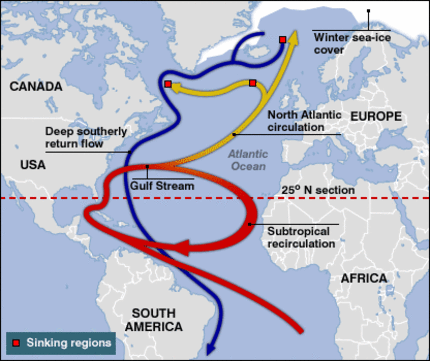
| |
 |

After the New Madrid adjusts, the Atlantic will adjust at the same
latitude, across from the continental US and from Mexico, which will surge
to the west. This would seem to place the tsunami directly across from the
mouth of the Mediterranean and Spain and the coast of Africa. But this is
not a typical tsunami that like most has a push in a particular direction.
Most tsunami results from a plate dropping or rising, and thus there is a
bulk of water with more pressure than the surrounding ocean. Thence the
rapid movement away from that point of pressure. If land rises the tsunami
is moving away from the back of the rise. If land drops, it is moving from
where water has rushed into the void, away from the lip of land that rose
above the dropping plate.
For the European tsunami, there will be a large void, a spreading apart,
not rising or falling land on either side of the fault line. When water
rushes in, it will clash in the center of the rift, and rise up. Thus,
undecided in what direction it wishes to go, it will be very subject to
the existing Gulf Stream, which will propel the excess water pressure in
that direction. The Gulf Stream does not go directly into the mouth of the
Mediterranean, which in any case could absorb a tsunami impact and dispel
it quickly. The Gulf Stream tends to curl in two directions: curling round
in a circular motion back upon itself and heading north toward Britain.
Where it curls upon itself, the bulk of the tsunami there will return to
the rift again, and settle, not causing any perceptible high tides along
the African coast or in the Caribbean.
But the thrust northward will continue and will assault the coastline of
the UK directly, and secondarily the coastline of France and Norway.
France can anticipate a tsunami of 100 feet, Spain perhaps 30-40 feet, the
UK 200-300 feet, and Norway 50-75 feet. The full brunt of the tsunami that
strikes the UK will also wash through the English Channel, entering the
North Sea, and clashing with any flow coming down from the Norwegian Sea.
The lowlands in the North Sea can expect a tsunami an estimated 100 foot
high. The speed and force of the tsunami as it reaches these lowlands will
be lessened, however, so blockades such as storm doors may be somewhat
useful in countries such as the Netherlands. Nevertheless, much flooding
will occur, forcing the residents in these countries to face what is
coming for them during the pole shift.
Was our statement that the coastlines of some areas would become
uninhabitable prior to the pole shift in regards to the European tsunami
and potential repeated hits? This and other coastlines will become
uninhabitable because of storms from the sea. The coastlines that have
been scoured clean of buildings because of the European tsunami will not
be resettled, and not just because of insurance issues. There will be
repeated tsunamis, though not as large as the initial one we have
described, but enough to keep the populace fearful of a repeat. The severe
wobble will also create tides that will assault coastlines in predictable
places. Follow where the ocean currents go today, and exacerbate them to
get an idea of what areas might be hit. This is not altogether a curse,
but a blessing, as residents on those coastlines will have moved inland
prior to the pole shift, for them, a life saving maneuver.
ZetaTalk ™ July, 2010
